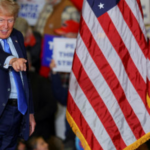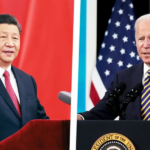INTRODUCTION:
The economy of the United States, frequently hailed as the global superpower, is a dynamic and intricate system that exerts significant influence over international financial markets.
Numerous elements, including fiscal policies, employment rates, inflation, and GDP growth, have an impact on the largest economy in the world. This article will explore the multifaceted elements that delineate the economic landscape of the United States.
Gross Domestic Product (GDP) and the Growth of the Economy:
The fundamental element of any discourse concerning the economy of the United States is the notion of gross domestic product (GDP), an indicator that computes the aggregate worth of all commodities and services generated domestically.
Due to its recent GDP growth of more than $21 trillion, the United States has maintained its position as the world’s largest economy. Over the course of its existence, this economic behemoth has undergone phases of rapid expansion, downturn, and recuperation.
The United States has demonstrated resilience in the face of adversity in recent years by maintaining consistent GDP growth. Consumer spending, business investment, and government expenditures are just a few of the factors that support this expansion. Policymakers and economists diligently observe GDP figures in order to assess the economy’s overall well-being and operational effectiveness.
Assigning and Losing Employment:
The state of employment on a national level is a key indicator of the economy overall. The labor market serves as an indicator of the capacity of the economy to produce employment opportunities and sustain livelihoods.
Unemployment rates have fluctuated in the United States, and the Great Recession of 2008 served as a sobering reminder of the economy’s susceptibility.
Government agencies, with the Bureau of Labor Statistics (BLS) being a prominent example, issue reports on employment and unemployment on a routine basis. In recent years, unemployment in the United States has been comparatively low, which is indicative of a robust labor market.
In addition, it is critical to take into account workforce participation rates, wage growth, and employment quality when assessing the economic environment.

Consumer Price Inflation and Prices:
Another crucial element in evaluating economic conditions is inflation, which refers to the overall escalation of prices for products and services. A moderate degree of inflation stimulates investment and expenditure, which is considered beneficial for the economy.
Nonetheless, an economy can become unstable and purchasing power can be eroded by excessive inflation. The U.S. Federal Reserve carefully monitors inflation and implements monetary policies in order to maintain price stability.
Inflation rates in the United States have largely remained within the Federal Reserve’s target range over the past few years. Consumer Price Index (CPI) and Producer Price Index (PPI) are fundamental economic decision-making and inflation trend indicators, respectively.
Regarding monetary policy and the central bank:
The Federal Reserve of the United States, commonly known as the Fed, exerts a significant influence on the economic terrain. The Federal Reserve, which was founded in 1913, is the central financial institution tasked with implementing monetary policy.
By means of open market operations and interest rate adjustments, the Fed attempts to fulfill its dual mandate of ensuring price stability and maximizing sustainable employment.
The Federal Reserve may employ expansionary monetary policies as a means to stimulate economic activity during periods of economic recession. On the contrary, in times of inflationary pressure, measures to calm the economy through contractionary policies may be implemented.
The ramifications of the Federal Reserve’s decisions are extensive, as they affect financing costs, investment choices, and interest rates in diverse industries.
Policy of the Government Fiscally:
Fiscal policy, which is under the control of the United States government, has a significant impact on economic outcomes in addition to the monetary policy that the Federal Reserve implements. Fiscal policy encompasses determinations pertaining to the administration of public funds, taxation, and government expenditure.
The U.S. government implements fiscal measures to address economic issues and promote development. For example, policymakers may employ stimulus programs to stimulate spending and extend financial assistance to businesses and individuals in times of economic recession. During periods of economic expansion, on the other hand, endeavors may be undertaken to diminish budget deficits and guarantee fiscal sustainability.

International Trade and Economic Relations:
By engaging in trade and economic relations with nations around the globe, the United States is an integral participant in the global economy. International commerce, which is substantially influenced by the economic landscape of the United States, is facilitated by imports and exports. As the difference between exports and imports, the trade balance is a crucial indicator of the economic condition of a nation.
Over the years, the United States has been the subject of debates and discussions regarding trade policies, including trade deficits, tariffs, and trade agreements. The intricate nature of international trade has an impact on a variety of industries within the U.S. economy, including manufacturing, technology, and agriculture. The global interdependence of economies emphasizes the significance of taking international factors into account when examining the economic environment of the United States.
Innovations in Technology and Economic Change:
Technological advancements have occurred at an accelerated rate in the twenty-first century, reshaping industries and altering the characteristics of labor. The United States, renowned for its technological advancements and centers of innovation like Silicon Valley, has been at the vanguard of this economic revolution.
Innovations in technology have generated the establishment of high-skilled occupations, increased productivity, and the emergence of novel industries. Concerns have been expressed, however, regarding job displacement, income inequality, and the digital divide as a result of this innovation wave. Policymakers and economists are confronted with the difficult task of striking a balance between promoting innovation and tackling the obstacles that accompany economic transformation.
Inequality in Income and Its Social Implications:
An enduring obstacle confronting the economy of the United States is the matter of income inequality. Societal ramifications result from income distribution disparities, which influence healthcare accessibility, educational opportunities, and economic mobility as a whole. The discourse surrounding income inequality includes considerations of social safety nets, tax policies, and the minimum wage.
A comprehensive strategy is required to combat income inequality, which consists of education reforms, targeted social policies, and tax system adjustments, among others. Amid the ongoing economic challenges confronting the United States, policymakers persistently prioritize addressing the matter of income inequality in an effort to establish a more inclusive and equitable economic environment.
Outlook for the Future and Obstacles:
Despite demonstrating resilience and adaptability, the U.S. economy continues to confront persistent challenges that necessitate strategic resolutions and thoughtful deliberation. Uncertainty in the economic sphere may be introduced by external factors, including geopolitical tensions, natural disasters, and public health crises.
Commencing in 2019, the COVID-19 pandemic underscored the interdependence of worldwide economies and the imperative for adaptable reactions to unanticipated obstacles. In light of the economic repercussions of the pandemic, the United States enacted unprecedented fiscal and monetary measures, placing particular emphasis on the value of adaptability and ingenuity in the formulation of economic policy.

CONCLUSION:
The economy of the United States, an intricate fabric comprised of numerous economic indicators and policies, exemplifies the country’s fortitude and flexibility. A multitude of elements influence the economic environment, including employment rates, inflation, GDP growth, and international trade.
Amid obstacles and prospects, the United States continues to strive for economic stability, inclusiveness, and sustainability; this remains a common objective among policymakers, businesses, and individuals. Comprehending the complexities of the United States economy yields significant knowledge regarding the factors that propel its advancement and mold its prospective course.








